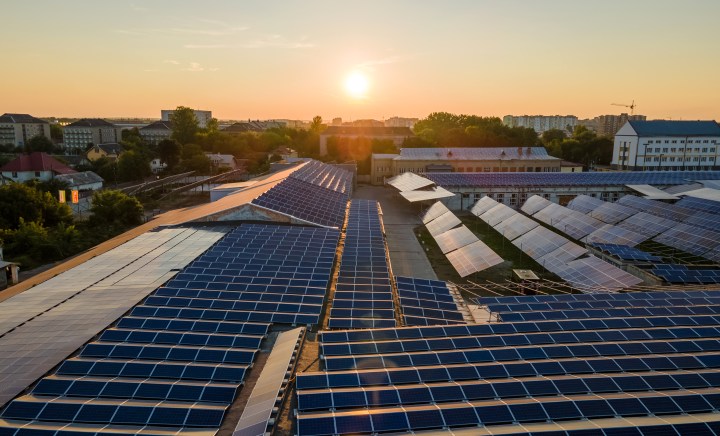LIGHT PAPER
Solar takes a load off but feed-in options are lagging behind the curve

Solar power has taken off in South Africa, even alleviating the energy supply shortfall by as much as 44% in the past year, but as much as 40% of energy generated was lost due to slow uptake of (and lack of) feed-in options.
This was just one of the findings of the GoSolr inaugural “light paper” released last week, which distils the current conversations about solar and renewable energy, interrogates the latest stats and key issues, and shines a light on the energy generation issues South Africa is facing.
“We developed the GoSolr quarterly solar update… to identify the issues and opportunity therein to tackle not only the ongoing energy crisis, but also to look ahead to better ways to power our vibrant nation,” said GoSolr co-founder and chief executive, Andrew Middleton.
GoSolr points to a “patchwork policy programme”. With the National Energy Regulator of South Africa (Nersa), the government, Eskom and 257 metropolitan, district and local municipalities operating in a near-siloed manner, the many players and inconsistent regulatory frameworks have resulted in a patchwork policy problem, while energy tariffs and electricity prices continue to rise.
“Municipalities buy and sell electricity at different rates, and only a handful allow homes and businesses to inject excess solar power into the grid,” the report says. One of the bigger obstacles is the cost of the bidirectional meters needed to feed power back into the grid. Currently priced between R10,000 and R12,000, this is unaffordable for most South Africa households that are just trying to keep the power on.
Cape Town energy plan a blueprint for South Africa
Middleton says the high upfront cost of the bidirectional meters coupled with most of the feed-in tariffs around the country mean it is not worthwhile for consumers to go this route. The City of Cape Town, which is widely coming to be known as a blueprint city when it comes to energy management, allows residents to register with its Cash for Power programme. Municipal bills are credited automatically, with the option to apply to earn cash beyond a zero balance. Businesses have been able to earn cash for power since June 2023, and the door was recently opened for residents to do the same.
The feed-in tariff of 87c per kilowatt hour excluding VAT has been approved by Nersa, with the city offering customers an additional incentive of 25c per kWh excluding VAT.
By the end of February this year Cape Town businesses and households had already earned more than R25.8-million, according to city management. Mayor Geordin Hill-Lewis said that by 1 February there were 1,461 sellers benefiting from the Cash for Power scheme as part of the City’s broader plans to end load shedding over time. Of these, 869 were residential and 592 were commercial/industrial.
“I consider this some of the best money we’ve ever spent and cannot wait to see how this programme expands even more over time. Not only are we adding crucial kilowatts to our grid at a cheaper cost than Eskom’s supply, we are also putting money back in the pockets of Capetonians. That is how you democratise energy and truly put power in the hands of the people,” he said.
Cape Town plans to add up to one gigawatt of independent power supply to end load shedding in the city over time, with the first 650MW within five years, including enough to protect against another four Eskom load shedding stages by 2026.
In the first quarter of this year South Africa had 68 days of load shedding out of a total of 89 days. The GoSolr paper shows that without rooftop solar alleviating demand on the national grid, the energy shortfall in 2023 would have been 44% worse than it was.
“South Africa ranks third in the world as having the best solar potential, and it’s becoming accessible to more people. The scope for growth and benefits [is] incredible – cost savings, clean and secure energy, job creation and more. We are, however, being hampered by inconsistent and fragmented national policy, regulations and tariffs,” Middleton said.
Read more in Daily Maverick: Eskom news
Last year alone, the country’s electricity demand exceeded supply by about 16 million megawatt hours, but Middleton says without rooftop solar, the gap would have been about 23 million MWh.
However, Eskom system operator Isabel Fick says that while solar power is the biggest part of private generation, it is only able to contribute between 9am and 6pm, leaving Eskom to pick up the morning and evening peak demand hours.
Eskom anticipates limiting load shedding to Stage 2 this winter, with reduced unplanned outages expected to range from 14,000MW to 15,500MW and a maximum of 17,000MW of unplanned outages at Stage 5. This forecast is a marked improvement from winter in 2023, which predicted unplanned outages ranging from 15,000MW to 16,500MW and a maximum of 18,000MW – a scenario where the maximum unplanned outages, or Stage 8, were successfully avoided. DM


















I feel that Eskom’s observation that solar only works during the daytime ignores the fact that most residential installations are hooked up to large batteries. Thus I think they are, in fact, understating the benefit that solar installations are providing.
Residential installations are a minority of total solar.
Batteries do have a role to play because they can be discharged during the evening peak demand time. Now you or I won’t do that, because those batteries are our protection against load shedding. This is where IPPs come in. They can have fields full of batteries, and more fields full of panels to charge those batteries. So we get projects like Kenhardt (up and running) with controlled discharging from the batteries that supply power into the grid from 5:00 to 21:30.
Meanwhile us owners of domestic rooftop systems can give ourselves a pat on our collective back. We did help draw some of the sting simply be reducing demand.
The ANC again ignored international best practices by selecting only to support big solar and wind farms only to find out that they don’t have network capacity. Mistake number 1.
Municipalities still see PV solar as a threat instead of an opportunity. Few have the skills to understand the concept of Time of Use and Energy Arbitrage. Municipalities pay substantially more – up to R6/kWh in peak times vs R0.50/kWh in off peak. Large container size Battery Storage Systems (BESS) can be charged off peak and then provide Megawatts during peaks. This is commercially viable and available. This function is also available to households where systems like Tesla can feed the grid from batteries, making money for the owner.
Even the excuse for the expensive bidirectional meter has a simple solution – use two conventional ones back to back. The one measures incoming energy and the other measures outgoing energy.
Even the network capacity issue can be resolved without building new networks by recabling existing networks.
The skills, knowledge and experience to make South Africa great is available. But the government has become the iceberg that hit the Titanic, sabotaging itself again and again. The end of the Rainbow nation not being a pot of gold but instead a sunken ship.
Excellent analysis. Lately reconductoring has been coming up in international articles and YouTube channels I follow but I haven’t seen much discussion of it in SA. As to Time-of-Use, it should be made mandatory for all residential and SMME customers (the large industrial users will always have the clout and rationale for negotiated rates.
Your point on the metering solution is interesting. I think as long they are two smart meters it would work. There needs to be a way remote monitoring for usage analysis and anti-tampering (though, I’m not thrilled about the control that would give the municipality over my meter).
We can always hope Eskom and the municipalities will concession or sell their distribution systems to private distributors who could then more efficiently incentivise meter and substation upgrades to more intelligently move the electrons around.
There are already mechanisms in place (in Johannesburg certainly) to monitor and to check for tampering, though at the moment these rely on technicians visiting premises. Anybody who installs solar will find this out. The City will notice the drop in consumption and send somebody out to see what’s going on. There is no default accusation of wrongdoing, though they will check for bypassing as it is one possible explanation.
COJ are busy with a meter auditing program. Part of that is to check that meters are where they should be, but another part is to check for tampering.
The fly in this ointment is load shedding. I have a PV system with batteries. The batteries get charged for free most days, and I could start dumping the contents of the batteries back into the grid starting around 6pm. But I won’t. Because we have load shedding. And because substations fail.
If I had a reliable grid supply then I’d play the game of charging the batteries for free during the day and discharging them for a credit at night. If we had affordable TOU tariffs AND a reliable supply then I’d charge the batteries up again at 2 in the morning when the power is cheap and discharge into the morning peak when the price is high again and pocket the difference.
But we do have load shedding (this situation is improving, but Eskom have been honest and told us that it will return in the winter). We do have infrastructure failures. We do have cable theft. And so those batteries are what keep my lights on. They are my security. And so I’m not using them for anything bar powering my home.
Sorry to be so blunt (not sorry).
We need better tariffs. At the moment in Johannesburg there is a TOU tariff that changes the price you pay for electricity according to time of day. BUT it doesn’t change what they pay you for feeding in. That price is fixed. I get the same amount for reselling in the middle of the night as I do at 7 in the evening when demand is high.
And we need a reliable supply.
For businesses the deal is better. For homeowners feed-in is hard to justify.
The trouble with conventional meters is that they can sense current but not the direction of the current. So when my system is feeding back, the meter can’t tell that this is feed-in current. This is why so many people set their systems to not export.
How would two conventional meters solve this problem? I take “back to back” to mean in series. In which case they will both see the same current and continue to not detect the direction. If in parallel they will see half the current each, and still not detect the direction.
In the case of two in parallel you’d have to add both meter’s readings together to get the bill for one property. Which just increases admin costs.
There’s a reason those bi-directional meters are expensive (even in places where the DA governs). They have to do a more complicated job (especially if TOU comes into play) and so they need to of a more sophisticated design and require more components.
The slow uptake on feed-in almost doesn’t matter. The primary benefit for the country is the reduction in demand for grid electricity.
Thank you very much for this information, though the topic itself still goes over my top. However, I think that for individual households to benefit with less admin hurdles and concerns about municipal inefficiencies, the IPPs must collect or buy the excess from the households. In that way all administrative issues remain with the IPPs